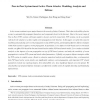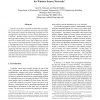1447 search results - page 4 / 290 » Simulating Internet Worms |
INFOCOM
2003
IEEE
13 years 11 months ago
2003
IEEE
— It has been clear since 1988 that self-propagating code can quickly spread across a network by exploiting homogeneous security vulnerabilities. However, the last few years have...
WORM
2004
13 years 7 months ago
2004
A major challenge when attempting to analyze and model large-scale Internet phenomena such as the dynamics of global worm propagation is finding ate abstractions that allow us to ...
COMCOM
2008
13 years 5 months ago
2008
Active worms continue to pose major threats to the security of today's Internet. This is due to the ability of active worms to automatically propagate themselves and compromi...
ICDCSW
2005
IEEE
13 years 11 months ago
2005
IEEE
Internet worms have repeatedly revealed the susceptibility of network hosts to malicious intrusions. Recent studies have proposed to employ the underlying principles of worm propa...
PADS
2005
ACM
13 years 11 months ago
2005
ACM
Most well-known Internet worms, such as Code Red, Slammer, and Blaster, infected vulnerable computers by scanning the entire Internet IPv4 space. In this paper, we present a new s...


